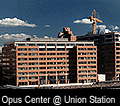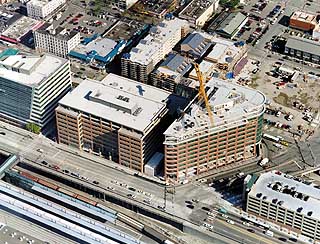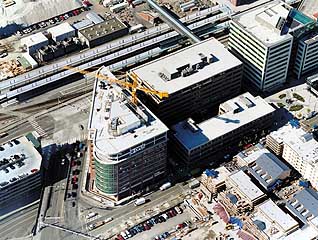
DJC.COM
Union Station
November 9, 2000
Seattle’s biggest jigsaw puzzle
Coughlin Porter Lundeen
Imagine trying to put together a jigsaw puzzle where each piece is designed by a different person, at a different point in time, and the picture on the box is only half finished. That’s the challenge that faced Coughlin Porter Lundeen, the Seattle-based engineering firm responsible for site civil and structural design for the Opus Center project.

|
The first piece of the puzzle is the bus tunnel lid, built in 1985. This piece was designed to be flexible enough to accommodate either a private office complex, or allow for the possibility of a civic center that would bring together multiple city buildings such as the City Hall and the Justice Center. Flexible as it may have been in 1985, by the year 2000 the column support layout no longer worked for modern open-plan offices.
The second piece of the puzzle materialized in the late 1990s in the shape of the parking garage. The addition of the garage provided the opportunity to seismically reinforce the existing tunnel lid and also created a specific plan for future office layout.
At this point the picture on the box was beginning to emerge. The concept was for four separate buildings, two of which would straddle the bus tunnel lid. Under usual circumstances, each building would have its own separate seismic system. But in this case, due to the disruption of the bus tunnel running beneath three of the buildings, it was necessary to tie all of the structures together into the same seismic system.
Tenants in the Opus Center buildings would be surprised to know that they are all bundled together by what amounts to a giant rubber band! This seismic joint consists of a rubber membrane that runs east/west between Building Two and 505 Union Station before sneaking under the corner of Starbucks and turning north to run along the east wall of 505 Union Station.

|
The underground parking garage has to resist the loads from all three buildings. A series of concrete shearwalls distribute the loads from the overhead structures. They were constructed as needed, as each building came online and an elaborate lateral model showing the garage, lid, and the three buildings was used to confirm the exertion of lateral forces.
Ask anyone which of the four buildings is the most unique and the answer will inevitably be: "The green glass one that leans, of course." However, the east and the south buildings, though less assuming, both hide unique qualities beneath their beautiful brick facades.
The elevator pits already set in the tunnel lid demanded some creative thinking to fit central core braced frames into the buildings, but Building Three defied the system. The alternative required the dusting off and re-establishment of a system common in Seattle’s history. Building Three now has the distinction of being the first Seattle structure built since the Northridge earthquake to have perimeter moment frames. Working with the city, Terry Lundeen, principal in charge of structural design, was able to design a process to define, construct and inspect these systems to current seismic standards.
The other dark horse on the block is Building Four, to the south. As with 505 Union Station, the column layout provisions in the bus tunnel did not match up with the desired column layout for the office space. Hidden beneath its straight walls and right angles, is an exercise in column gymnastics that would put 505 to shame.
"Opus South actually wants to lean more than 505," confesses Lundeen. "Its columns are cantilevered out toward Airport Way and a series of transfers carries the weight back down to the columns in the garage. It’s just well hidden."
Fifteen years may be a long time to complete a jigsaw, but it looks even better than the picture on the box!
Jill Jago is the marketing director at Seattle-based Coughlin Porter Lundeen.
Other Stories:
Copyright ©2009 Seattle Daily Journal and DJC.COM.
Comments? Questions? Contact us.